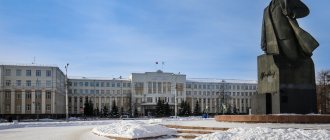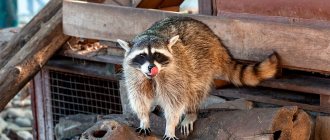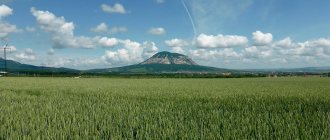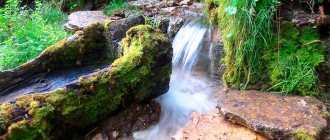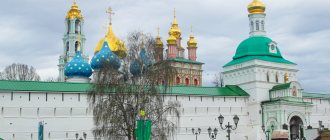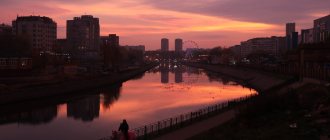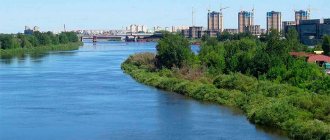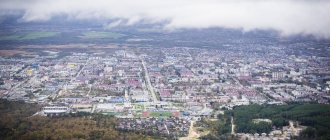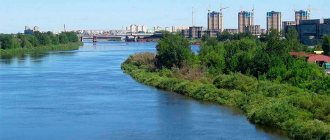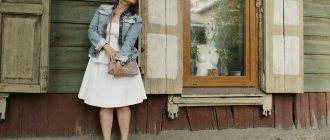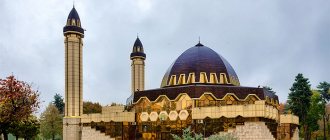Georgia is a country bordering Russia and having a rich heritage. There are architectural monuments not only in its capital. Kutaisi is an ancient city with a colorful history, located on the banks of the Rioni River. Once upon a time it was a capital city, but now it has the status of an administrative center and ranks second in terms of the number of residents. What to see in Kutaisi and the surrounding area, coming there on vacation or on a business trip, for a week or just a couple of hours. Everyone will find something special for themselves in this town.
A little about the location
The muddy and fast waters of the river divide the territory of the town into two parts, connected by original bridges, which can rightfully be considered historical monuments and values. The right bank is its old area, where walking along the roads made of paving stones, you can see all the main attractions of Kutaisi. If you came to the city by car, it is better to leave it and walk through the streets on foot. Kutaisi is a compact and small city, mainly consisting of five-story buildings mixed with small private houses. It will simply be inconvenient for transport there. The left bank is a modern center with the latest buildings and entertainment, but it is worth noting that you will not see the metropolitan splendor and gloss reminiscent of the current capital.
Although Kutaisi has ceased to be the capital of Georgia, it is still an important cultural, economic and business center, due to its location on the main highway connecting the west and east of the country. It is necessary to cover a distance of 220 km to Tbilisi, 150 km to tourist Batumi, and 100 km to the Georgian city of Poti.
Sights of Kutaisi and the surrounding area include many interesting modern and historical places.
Where to eat deliciously in Kutaisi
Restaurant Sisters
My favorite restaurants
Sisters restaurant serves amazing chicken in pomegranate sauce with honey and prunes, chikhirtma and iced coffee.
The small, three-table restaurant Palaty is the best in the city, in my opinion. Take chakapuli soup with lamb and tarragon, cold matsoni, any meat. All the dishes there are very tasty. Their Palaty wine is amazing.
The colorful kebab shop Bikentia , opened in 1956. For 64 years they have been preparing delicious kebabs. They eat them right there at the bar - there are no tables in the establishment.
Papavero serves huge Adjarian khachapuri .
Fleur cafe makes delicious cappuccino, and the neighboring shop sells churchkhela with nuts, prunes, and raisins. They are conveniently located next to the park.
Imereti cuisine
Imereti is the most delicious region of Georgia, in my opinion. A lot of seasonings and herbs are used here, making the dishes aromatic and memorable. I'm not a big fan of "cheap and filling" style food, like cheese and bread. My taste buds were delighted with Imeretian cuisine.
Chicken in sweet sauce- Chakapuli
For example, they prepare endless variations of pkhali - a snack made from herbs and nuts. What is not used for pkhali: beet tops, spinach, nettles, cabbage. There are more than 200 recipes for this dish!
Chicken is the main dish on the table. The key to the success of the Imeretian housewife is a fantastic sauce. Bazhe nut sauce, garlic, tomato-nut sauce with herbs, pomegranate with honey, or my favorite isrim-makvali - made from unripe grapes and blackberries. Instead of bread, they will serve mchadi - flatbreads made from corn flour.
A popular dish is lobio made from beans, cilantro and onions. Chakapuli made from tender lamb with a lot of tarragon (or tarragon) is very tasty
Of course, Imereti has its own khachapuri. It's a closed flatbread with lots of local cheese. This dish is called imeruli .
Houses of Parliament
The city is also notable for the fact that since 2012, in order to support its economy, the parliament was moved from the capital to the western outskirts of Kutaisi, to an unusual futuristic building designed in the shape of a glass turtle, where the government gathers for sessions. There is a checkpoint three hundred meters away from it, so you can’t just go on an excursion. But this is possible by agreeing in advance, at least one day in advance.
Important! To do this, you need to leave on the website information about the number of people wishing to visit the building, their names and passport numbers, and then dial number 18 (Shota), and it will indicate exactly when an excursion to the Kutaisi parliament is possible (there should be no scheduled sessions on this day).
Reviews
Sergey, 34 years old. We have long wanted to come to Kutaisi, and finally our dream has come true. On the first day we visited almost all the sights of the city, the rest of the days we went to see interesting places nearby. Overall the trip was a success, but it is worth noting that this is not the cleanest city in Georgia.
Daria, 58 years old. We were vacationing in Batumi, but booked a one-day excursion to Kutaisi, and didn’t regret it one bit. I especially remember the visit to the Motsamete Monastery and the Bagrati Temple. The atmosphere of the city is quite calm and peaceful. We liked everything.
Olga, 40 years old. This is not a city, but a fairy tale. I fell in love with him at first sight. There is a feeling of peace and tranquility, and the hospitality of the residents cannot but surprise. Everyone invites you to sit down, chat and drink excellent Georgian wine, the taste of which cannot be compared with anything.
Kutaisi is an interesting ancient city that is definitely worth visiting at least once in your life. Many great attractions are located directly in the central area. But if you want more, head a little outside the city, where there are even more interesting places.
Temple of Bagrat
The history of this place dates back to 1000, when the building was part of the residence of the kings of Georgia. Now it is one of the main attractions of the entire city, a must-see. The cathedral was built by order of King Bagrat III, who was buried there. In 1691, during the invasion of the Turks, the temple was destroyed and stood inactive for 3 centuries. Near the entrance you can see illustrations and photographs of restoration work from 1990 to 1994. It was possible to save a lot of ancient fragments, these include sculpting, carvings and mosaics decorating the walls and floors inside.
The Bagrati Temple is located on the top of Ukimerioni Hill, so it offers stunning views of the entire city, thanks to which you can take many interesting shots.
Georgian SSR and independence
Soviet power caused damage to Kutaisi and its population. Sad events occurred in the 20s. Many families were affected by the shootings. Architectural structures also suffered. In 1924, the builders of communism considered the Kutaisi Cathedral an unnecessary relic of the pre-revolutionary era and demolished it.
During the era of “developed socialism,” Kutaisi transformed into a large industrial center of the country, the Georgian SSR. They began to actively build factories and develop industry here. They established the production of cars and tractors, built electromechanical, lithoponic and many other factories.
Independence gave the city a different, not very positive, status - Kutaisi became a criminal capital. One of the largest groups in Georgia operated here. They occupied an entire quarter - Chomi, and major authorities built themselves mansions and villas near the Outpost. Some of them have survived to this day and serve as a reminder of those troubled times.
In 2009, a large-scale reconstruction of the city began, which lasted until 2013. As a result of the work carried out, the Bagrati Cathedral and several old streets were restored, and the Sataplia National Park began to operate. The city became the parliamentary capital of Georgia in 2012 - a building was specially built here for parliamentary meetings.
Kutaisi Botanical Garden
Of course, in terms of landscape and gorgeous viewing platforms, it is inferior to its Batumi counterpart and does not reach the level of the huge Tbilisi botanical garden with a waterfall and canyon, but as a place to relax in the summer heat it is very good.
There is a unique attraction on its territory - a chapel built in the trunk of an old oak tree. The diameter of the tree is more than two meters, so three people can comfortably fit there.
The opening hours of the botanical garden are from 10:00 to 22:00, and you need to pay 1 GEL for entry.
Niko Berdzenishvili Historical and Ethnographic Museum
The museum stores unique examples of the country's cultural heritage from the 9th-7th centuries to the late Middle Ages. They include in western Georgia after excavations bronze and ancient monuments, Georgian, Greek, Roman, Byzantine and eastern history, life and culture of rare objects, ancient epigraphic monuments and Georgian manuscripts, rare, ethnographic materials, ceramics, jewelry, metal , ceramics, leather goods, glass, fabrics, wood products are highly significant examples.
Chain Bridge and Green Market
Chain is a car-pedestrian crossing over the Rioni River. Along with the famous White Bridge, it is a striking landmark of the city and leads directly to another famous place - the green market.
The bazaar occupies an entire block right in the city center, at the intersection of Lermontov and Paliashvili streets. This is the best place in the city where you can buy local Georgian delicacies and edible souvenirs. The stalls are filled to capacity with ripe, juicy peaches, oranges, and apples. Tourists from Russia and other countries come here for delicious suluguni, churchkhela, tkemali, satsebeli and spices for which Georgian cuisine is so famous.
Unlike the markets of Tbilisi and Batumi, where each product is sold in its own row - fish, meat, fruit, the Kutaisi bazaar is characterized by a more chaotic placement of goods: walking along the rows you can find cherries located next to corn flour, spices, next to chacha or greens next to oriental sweets. But this does not make it look disorderly, but on the contrary is a kind of zest.
What else to see in Kutaisi, and what attractions are located in the city, can be read below.
Kopitnari Airport
This is another symbol of modern, modernizing Kutaisi, just like the central square, bears the name of David the Builder. It is located 14 km from the city and can be reached by minibus going in this direction.
The terminal building is modern, glazed, a bit oddly shaped, but everything here is organized conscientiously. Very comfortable sofas with window sills will allow you to lie down and relax, this is much better than ordinary waiting rooms. A couple of shops, a tourist center, information desk, Wi-Fi - what else does a vacationer or tourist need? There is a car park and a car rental office next to the terminal. The length of the runway is approximately 2.5 km.
All these transformations made it possible to assign the airport category A and international status; it is the third most important in Georgia. It is planned to open new directions in the near future.
David the Builder Square with Colchis Fountain
An amazing place filled with history, one of the attractions of Kutaisi and the surrounding area. Until 1924, the Alexander Nevsky Cathedral was located here, which was demolished to erect a monument to the great leader Lenin, later replaced by a profile of Stalin.
This is interesting! In 1956, the city authorities decided to remove the statue and make a flowerbed, but the flowers did not take root on it and after the country gained independence, an equestrian statue of King David appeared in the long-suffering place. In 2011, the Colchis fountain was built around the statue, which is several times enlarged copies of golden artifacts: deer, horses, rams, aurochs, found near Kutaisi.
Once on the square, you can see several buildings and structures of interest to tourists. If you look to the north, you will see the round building of the Lado Meskhishvili Theater, and next to it is a sculpture of Meskhishvili himself. Also adjacent to the square is a city park, the entrance to which is decorated with tall white columns typical of the Soviet era.
If you go around the theater, you find yourself in Paliashvili Lane, along the path along which two museums were built - sports and military history. The theater building is also adjacent to Gelati Street, leading to the monastery of the same name.
Where to go from Kutaisi
Kutaisi is an ideal base for exploring the Imereti region. Most of the sights can be seen in one day, and you can return to Kutaisi for the night.
Geguta Palace - residence of Queen Tamara
How to get there . There is no public transport to the palace. You can walk in an hour and a half from the center of Kutaisi along Tabidze street, which smoothly flows into st. Nikea. A taxi will cost 15 GEL. Cost : free
Geguti Palace. photo from the site snovadoma.ru
The ruins of the royal palace of Geguti are located 7 km from Kutaisi. In the 8th century, there was a one-room house on this site, where kings stayed after hunting. The four-story building was built in the 11th and 12th centuries, around the same time as the Bagrati Cathedral. Probably, Queen Tamara lived there with her first husband, George the Russian, the son of Yuri Dolgoruky. It was a monumental building, painted with frescoes, with a large fireplace and wine storage. A garden was laid out around it, of which nothing remains.
Gelati Monastery - UNESCO
How to get there: Minibus No. 33 from Gelati Street. Hitchhiking in this direction is good. Cost : free
Frescoes in Gelati Cathedral
A beautiful monastery included in the UNESCO heritage list. It was built in the 12th century. The walls and dome of the temples are decorated with frescoes. Many Imeretian kings are buried inside.
Motsameta Monastery
How to get there : The monastery is located halfway between Gelati or Kutaisi. The journey on foot will take one and a half hours. Minibuses don't go there. Cost: free
Motsameta Monastery
The martyrs David and Constantine are buried in the Motsameta Monastery. They were princes of the Argveti region. When the Arab army of Marwan the Deaf attacked their lands in the 8th century, the brothers refused to convert to Islam. The Arabs tortured them for nine days and then drowned them in the river.
Read also: Monasteries of Gelati and Motsameta | Georgia
Trekking from Gelati to Tkibul Reservoir
How to get there : 25 km on foot, 9 hours. I recommend splitting the hike into two days. Cost : free
- The route map hangs near the Gelati Monastery
A walking route, developed in 2022, begins from the Gelati Monastery. Judging by the information on the Internet, no one has walked along it yet. The 25-kilometer trail passes through little-known churches above Gelati, the giant wild cave of Tsutskhvati and the ruins of the fortress of the same name, the Chalastavi Monastery. From here you can continue your journey to Mount Unagira, on the top of which stands the Basilica of St. George 10th century. It offers a view of the Tkibul Reservoir. On the descent to it there is some unknown Tskaldasavli cave.
Abandoned sanatoriums in Tskhaltubo
How to get there : 30 minutes from Kutaisi by minibus No. 30 from the Red Bridge. Cost : free
Medea Sanatorium in Tskhaltubo
A former resort town, in whose sanatorium the entire top of the Soviet government came for treatment. After the collapse of the USSR, hotels closed. During the Abkhaz War, refugees were resettled there. Some still live there, having never received housing from the state. You can walk freely through abandoned buildings, in which former luxury is still visible.
Read also: Abandoned Stalinist sanatoriums in Tskhaltubo
Prometheus Cave
How to get there : minibus No. 30 to Tskhaltubo, then minibus No. 42 to Kumistavi. A taxi will cost 10 GEL including waiting. Cost : 23 GEL guided tour (1 hour), 17 GEL walk along the river. Wedding ceremony - 115 GEL. Monday is a day off. Website : https://apa.gov.ge
Main hall of Prometheus cave
One of the largest caves in Georgia. It was discovered in 1983. The length of the cave is 11 km, of which only 1 km is shown to tourists. But there is also something to see there: huge halls, stalagmites and stalactites, beautiful lighting. Wedding ceremonies are held in the Love Hall, and you can take a boat ride on the underground river.
Read also: Prometheus Cave - the longest cave in Georgia
Sataplia Nature Reserve
How to get there : Minibus No. 45 from the market. Can be reached on foot - only 9 km from the center of Kutaisi. Cost : 17.25 GEL for a guided tour. Wedding ceremony - 100 GEL. Website : https://apa.gov.ge
Dinosaur tracks. Photo from geogid.net
In the 1930s, a local resident discovered fossilized dinosaur footprints in the forest. The reserve grew around them. In addition, in Sataplia there is a karst cave, a primitive man’s site, an ancient Colchis forest and the crater of an extinct volcano
Okatse Canyon and Kinchkha Waterfall
How to get there: by minibus to the village of Khoni (direction Martvili). Then take a minibus to Zed Gordy. The Kinchkha waterfall is 8 km from the canyon; taxi drivers are on duty at the ticket office. Cost: 17 GEL - Okatse, 17 GEL - Kinchkha. Monday is a day off. Life hack: in the off-season (from the end of October) admission is free, there is no security there.
Bridge over the canyon. Photo from v-georgia.com
One of the deepest (more than 50 m) and famous canyons in the country. A wooden path was laid right over the abyss - the whole canyon is in full view! Then you can walk to the 70-meter Kinchkha waterfall and Lake Lomina.
Pillar of Katskhi
How to get there: minibus to Chiatura, ask to be dropped off at the turn to Katskhi. From there 2 km on foot Cost : free
Katskhi pillar
In the middle of the valley rises a lonely limestone pillar. Since ancient times, pagan rituals of worshiping the goddess of fertility have been held around it, and the ruins of a 6th century temple were discovered at the top. In 1993, monasticism on the pillar was revived. Now monk Maxim lives there.
Chitatura - a mining town
How to get there: minibus to Chiatura from the central bus station of Kutaisi Cost : cable car ride - about 20 tetri (5 rubles)
The first cable car of the USSR
A tough mining town where manganese has been mined since the 50s. Here you can ride the very first cable car in the USSR, which, it seems, has not been repaired since its installation. Near Chiatura there is the Mgvimevi cave monastery.
Read also: Mining town of Chiatura and Katskhi pillar
Mountain of Nine Crosses
How to get there: minibus to Tkibuli, drive 3 km along the highway and from there hike to the top. The cable car marked on the map has not been operating since the collapse of the USSR. Cost : free
Mountain of 9 crosses. Photo from the site dikarem-ge.livejournal.com
Mount Tskhrajvari (1569 m) is located on the border of the Racha and Imereti regions, not far from the mining town of Tkibuli, where coal is mined. At the top are the ruins of a temple and nine crosses. It’s worth going up here for the view of the Tkibul Reservoir and a walk through the boxwood forest.
Archaeological Museum in Vani
How to get there: by minibus with a change in Samtredia. The museum is located on the street. Lortkiparidze, 32. Closed on Mondays. Cost: 3 GEL Website: https://museum.ge
Photo from www.newsgeorgia.ge
During the Colchis kingdom, Vani served as a sanctuary. The city was destroyed in the 1st century AD. In 1985, archaeologist Otar Lortkipanidze discovered the ancient settlement, the foundations of temples and the remains of altars, as well as gold and bronze items. Some of the items found date back to the 8th century BC.
The famous “Toastmaster”, who now adorns the Colchis fountain in Kutaisi, comes from Vani. This is a 3-centimeter figurine depicting a seated man with a horn in his hands. The Georgians decided that the horn contained wine, and the man himself was dubbed the first toastmaster in history.
The museum was expanded in 2022. A new 4-story building was built there, the road was widened, and a parking lot was built.
Hot springs near the village of Amagleba
How to get there: on foot/by taxi from Vanya, 10 km. Cost: free
Photo from visitkutaisi.com
There are thermal springs between the village of Amaghleba and Vani. They are located on the left bank of the Rioni, 100 meters from the shore. You can swim in a warm pool and immediately jump into a cold river. The place is not touristic, not even all locals know about it.
Kennel of Caucasian Shepherd Dogs in the Tobakini Monastery
How to get there: by minibus to Zestafoni, from there 8 km to the monastery (on foot or by taxi). Cost: free
A monastery arose on this site in the 7th century. It was richly decorated with frescoes, but under Soviet rule it was looted and destroyed. Since 1992, Caucasian Shepherd dogs have been bred here. The nursery is considered one of the best for this breed. You can just come there to walk the dogs and chat with the monks.
Ubisi Monastery
How to get there: any transport following the Tbilisi-Kutaisi route. Get off at the unfinished bridge, before reaching 24 km to Zestafoni. The village on the map is called Ubisa. Cost: free
Ubisi. Photo from exoticgeorgia.ru
The temple in Ubisi was built in the 9th century, when these lands belonged to the Abkhazian kingdom. The most interesting thing about this rarely visited temple is its frescoes. They date back to the 14th century and are perfectly preserved.
Baghdati is the birthplace of Mayakovsky
How to get there : take a direct minibus from Kutaisi (from the central bus station) to Bagdati, then walk 2 km towards the Sairme resort. The museum is located on the outskirts of the city, on the street. Bagdati, 51 Cost : free
House-museum in Baghdati
Vladimir Mayakovsky was born in Bagdati in 1893. His father worked in the Bagdat forestry. He rented a house from Konstantin Kuchukhidze, whose descendants now own the museum. The poet lived in Baghdati until 1902, after which he entered the gymnasium in Kutaisi.
“The first house, clearly remembered. Two floors. The top one is ours. Nizhny is a winery. Once a year - carts of grapes. They pressed. I was eating. They were drinking. All this is the territory of the oldest Georgian fortress near Baghdad. The fortress is quadrangular with a rampart. In the corners of the shafts there are ramps for cannons. There are loopholes in the ramparts. Behind the ramparts are ditches. Behind the ditches are forests and jackals. Mountains above the forests. Grown up. I ran to the highest one. The mountains to the north are falling. There is a gap in the north. I dreamed that this was Russia. I was incredibly drawn to it.”
V. Mayakovsky. "I myself"
Sairme resort
How to get there: by direct minibus from the central station in Kutaisi, at 10:50 and 17:50. Cost: water and walk - free. Rest in a sanatorium with meals and treatment - $100 for two per day. Just a hotel room - $50 for two.
Sairme
Resort in the mountains at an altitude of 1000 m above sea level, with Narzan type mineral water. There are forests and mountain rivers around. On the territory of the sanatorium there are springs where 4 types of medicinal water come out.
Historical Museum
Museum named after Brdzenishvili was founded in 1922. All the finds that archaeologists accumulated during excavations on the territory of Imereti are presented as exhibits. A ticket for an adult costs 3 GEL, for students the price is 1 GEL, for students - 2 GEL, very young children are admitted free of charge. For 10 GEL they offer an individual excursion.
Housing
More than 100 accommodation options have been prepared for tourists, including family-type mini-hotels, hotels, etc. The top three are complexes with their own parking lots and green areas:
- Continental Hotel
- Edemi
- Old
The average daily price is from 2200 to 7000 rubles. In hostels, beds are, of course, much cheaper.
To be fair, it must be said that the main attraction of Kutaisi is its residents, hospitable and open, ready to treat a stranger, help with friendly advice, or simply support. The atmosphere of the city is filled with the heady aroma of fresh bread, painted with a wide palette of colors and luxurious green herbs, mountains of fruits and vegetables. It attracts so much that it is difficult not to return here.
Queen Tamara Street
This short but very important kilometer-long street on the left bank of the city is worth paying attention to, due to the fact that most of the hotels in the city are located in the areas adjacent to it. It lasts from the railway station to the Meskhishvili Theater described above. Moving from the train arrival point, along Tamara Street you can go to the very center of the city. The street is famous and is depicted in photographs and souvenirs with Kutaisi sights.
Transport and getting around the city
Mostly minibuses travel around Kutaisi, but there are also buses, and the most important of them is No. 1. Remember this number. It goes from the railway station along Queen Tamara Street, then through the square and the park, across the Red Bridge and further to the bus station.
The railway station, where trains from Tbilisi and Batumi arrive, is called Kutaisi-1 and is located on Tamara Street, from here you can walk to the center in 15 minutes.
The main bus station is located on the street. Chavchavadze near McDonald's, away from the historical center. There you will find many minibuses to all parts of Imereti. However, minibuses to the Sataplia and Tskhaltubo reserves depart from the Red Bridge in the center. And transport to the Gelati Monastery leaves from the parking lot behind the drama theater. I marked all these points of Kutaisi on the map at the bottom of the post.
A taxi around the city will cost about 60 tetri per kilometer; in a large group it will be even more profitable to take a taxi.
Kutaisi city
Royal Quarter of Kutaisi
The “Royal Quarter” is the name given to the historical part of Kutaisi, consisting of 6 streets and 38 buildings that were built between the 18th and 19th centuries.
The Mon Plaisir arch is the entrance to the Royal Quarter. Translated from French, the phrase means “my pleasure,” as if pushing for the fact that a walk through historical places will bring a lot of positive emotions. Be sure to take a couple of photos as a souvenir. To the north of the Royal Quarter is the Opera House, and to the west is one of the most famous attractions of Kutaisi - the White Bridge.
Balanchivadze Opera and Ballet Theater
Address: Kutaisi, st. Tsminda Nino, 17.
The Meliton Balanchivadze Opera and Ballet Theater is located in a beautiful building from the early 20th century. In 2010, the building underwent a large-scale reconstruction, as a result of which 13 statues of Roman soldiers and sitting lions by local sculptor Georgiy Kikvidze appeared on the roof. Now completely reconstructed and actively working, the theater is a real decoration of the city.
Bridges over Rioni
Between the Royal Quarter and Gaboshvili Park there are three parallel bridges across the river: Red, White and Rustaveli Bridge.
Historical reference! The White Bridge was built back in 1872 and to this day it is repainted every year exclusively in snow-white color. On the bridge itself there is also a remarkable creation - a sculpture of a boy with two hats. This is the hero of the 1968 film “An Extraordinary Exhibition”, representing the ideal of art. From this place you can see the white stones of Rioni.
You can admire the beauty of the white bridge from the neighboring Rustaveli Bridge. The Red Bridge is a pedestrian bridge, from which you can clearly see the real Kutaisi, without tourist motives. Between these two bridges stands a monument to the poet Galaktion Tabidze.
What to see in the city: description and photos
Temple of Bagrat
The temple in the classical Byzantine style, located on Ukimeron Hill, is considered the main attraction and shrine of Imereti. This is not even a temple, but a whole cathedral, since the bishop sits in it. The locals call it “Bagrati Cathedral” or “Bagrati”.
The temple was built in the 11th century on the initiative of King Bagrat III, in honor of the Dormition of the Virgin Mary. This king, the first unifier of Georgia, was buried there.
Also, another great king of Georgia, David IV the Builder, was crowned in the cathedral. For this reason, Bagrati has not only historical, but also symbolic value for Georgians, as a monument to the unification of disparate principalities into a single country.
Reference. As a result of the Ottoman invasion of the 17th century, as well as the shelling of General Totleben in the 18th century, the temple fell into a dilapidated state. It remained in this form for three centuries until the authorities of independent Georgia began restoration.
Address and coordinates: Bagrati Street, Kutaisi (42.277247, 42.704299).
Embankment on the northern bank of the Rioni River
Reconstructed promenade on the way from the Bagrati Temple to the Botanical Garden. A nice place for a walk, where in the summer you can enjoy the coolness coming from the mountain river.
Address and coordinates: David and Constantine Mkheidze st 13 (42.27459, 42.70316).
Botanical Garden
Important! The second largest botanical garden in Georgia, whose collection includes 700 species, 200 genera and 80 botanical families: trees, bushes, flowers and herbs. Of particular interest are cork oak, indigofera and magnolia.
The first green spaces appeared here at the end of the 19th century. They were brought here by the Scottish biologist Jacob Marr, who wanted to cultivate citrus, cotton, tea, and simply exotic plants from the subtropical regions of the planet in the South Caucasus. He was also involved in the introduction of advanced European agronomic practices.
In the 1990s, the garden fell into disrepair and almost ceased activity. But then funds were found to restore it.
After reconstruction, modern landscape design, fountains and fish ponds, an amphitheater, sculptures, paved pedestrian paths, new benches and gazebos, as well as normal lighting appeared there.
While here, be sure to look at the 400-year-old live oak tree, in the trunk of which there is a cavity where a Christian chapel was built. A person can easily fit inside it.
- Opening hours: from 10:00 to 22:00 - daily.
- Entrance fee: 1 GEL.
- Address and coordinates: S16, Kutaisi (42.279085, 42.712528).
Church complex "Mtsvane Kvavila"
A historical and architectural complex that arose on the site of urban development of the 12th century.
Attention! The name of the complex is translated as “Green Flower”, in honor of the Georgian poet Sulkhan-Saba Orbeliani, who brought unknown seeds from a European trip and presented them to a certain monk.
A delightful green garden appeared at the site where they were planted. The complex consists of several buildings:
- defensive stone tower with walls up to 2 meters thick;
- ruins of a 12th-century stone church;
- Church of the Archangels Michael and Gabriel in the neo-Byzantine style, built at the end of the 19th century;
- Mtsvane Kvavila Church, built at the beginning of the 20th century;
- pantheon of public figures.
The Pantheon is a small necropolis where prominent residents of Kutaisi are buried. In its center stands a 17th-century chapel.
Address and coordinates: 7PG8+FJ Kutaisi (42.276237, 42.716586).
Royal Quarter
An architectural ensemble of 38 buildings in the style of European classicism, built in the 18th-19th centuries. The houses are located on six streets.
Reference. At the entrance to the quarter there is an arch with a strange French phrase “Mon Plaisir” (my pleasure).
Its meaning is unclear, but it looks mysterious and impressive. This is a typical Eastern European historical center, which is what you least expect to see in the Caucasus, where they adhere to eastern urban planning traditions.
Cute houses and cobblestone streets, youth cafes and public spaces, murals and art objects give the Royal Quarter a special European luster.
Address and coordinates: 7P92+PM Kutaisi (42.269372, 42.701691).
Jewish Quarter
Important! The Jews, having been expelled from their land, settled throughout the globe. At the same time, they did not dissolve in other nations, since they always knew how to preserve their identity. This happened in Kutaisi, where Jews appeared in the 6th century BC. having fled there after the burning of Jerusalem by the Babylonians.
Initially, there were few settlers and they did not have a cultural impact on the city. But between the 17th and 19th centuries, their number rapidly grew from 500 people to 4000. The community settled the entire quarter, building community houses, 3 synagogues, craft workshops and trading shops there.
Under Soviet rule, the number of Jews reached 15,000, but almost all of them repatriated to their homeland in the 1970s. Now all that remains of the huge diaspora are buildings and 40 families, mostly elderly.
Address and coordinates: Nizami Street, Kutaisi (42.274175, 42.709137).
Palace of the Imeretian Kings "Okros Chardahi"
Okros Chardahi is translated as “Golden Tent”. These are the remains of the residence of the Imeretian kings. Once there was a complex of buildings from the 13th century: a large and small house, a church, a dining room and utility rooms. They received ambassadors and petitioners, held feasts and administered justice.
Attention! To this day, only a small house has survived from the residence. Inside it there is a museum with objects from the reign of the Bagrations.
Address and coordinates: 9 a Rustaveli Avenue, Kutaisi (42.269930, 42.700510).
The building is located immediately behind the Kutaisi Information Center.
Colchis fountain on David the Builder Square
The square went through several iterations before taking on its current form. First there is the Alexander Nevsky Cathedral, demolished by the Soviet authorities in 1924.
In its place, a monument to Lenin was erected, which a decade later was replaced by a statue of Stalin. In 1956, that monument was also demolished and a flowerbed was built in its place.
Reference. After the country gained independence, a monument to David the Builder on a horse was erected on the square. In 2011, it was moved to the station, and in its place a pompous cascading fountain was erected, illustrating the myths of Colchis.
Its levels are decorated with thirty gilded animal figures - copies of Bronze Age figurines found during excavations in Georgia. You can look at the original figurines at the Georgian National Museum in Tbilisi.
Address and coordinates: 7PC4+H5 Kutaisi (42.271496, 42.705488).
Theater named after Lado Meskhishvili
The theater was built in 1860 with 700 seats. It is an oval building in the Russian Renaissance style, with a dome, arched windows and columned galleries in front of the windows and the central entrance. The walls are made of white stone and decorated with bas-reliefs.
Important! The theater was named after the Georgian actor and theater director who directed the theater in the 20s of the 20th century.
- Opening hours: find out the schedule and cost of events at the entrance.
- Address and coordinates: Gelati St, Kutaisi (42.272379, 42.705491).
Historical Museum
The second largest historical museum in the country, opened in 1922. It demonstrates finds made during excavations in the Imereti region and throughout Western Georgia.
These are fossils, tools and jewelry of the Stone and Bronze Ages, objects of art and everyday life of antiquity and the Middle Ages.
Attention! The museum has a good collection of Byzantine and early Christian bas-reliefs.
- Opening hours: from 9:00 to 18:00 - daily.
- Entry fee:
- adults - 1 GEL;
- children under 16 years old - 1 lari;
- students - 2 GEL;
- Children under 7 years old are admitted free of charge.
- Address and coordinates: 7P93+FJ Kutaisi (42.268722, 42.704041).
Church of St. George
A 13th-century Byzantine-style church made of hewn limestone slabs. There is a legend that it was erected on the spot where the spirit of St. George appeared to King David the Builder. Research has shown that it has never been rebuilt and has retained its original appearance.
Reference. The interior is painted with frescoes from the past Middle Ages, which illustrate church scenes and moments from Georgian history.
Address and coordinates: 7PG5+7J Kutaisi (42.275694, 42.709062).
Blagoveshchensky cathedral
A church with a complex history. Initially, it was an Orthodox church of the 15th century. At the beginning of the 19th century, it was handed over to Catholics, who converted the Byzantine style of the building into Baroque, adding a columned portal with inscriptions in Latin.
Under Soviet rule, the temple was closed, and it remained in this state until 1989, when it was transferred to the Orthodox Church. However, the spirit of Catholicism never disappeared from there.
Important! Inside, Orthodox frescoes are surprisingly combined with ceiling paintings and Vatican-style decor.
Address and coordinates: 7 Varlamishvili Street, Kutaisi (2.275013, 42.705974).
City bridges
Kutaisi is divided by the Rioni River into two parts: Northern and Southern. There are many bridges across it. Three of them are of some interest in terms of architecture and the views they offer.
Chain
Arch bridge in constructivist style. It was built in 1770 on the site of a crossing that rested on the foundation of an ancient bridge of the 5th century. That crossing was constantly destroyed during floods, so it was replaced with a bridge on wooden supports. In 1850, these supports were suspended from a chain.
Attention! In the late 1880s, the bridge was rebuilt again, replacing wood with stone and metal structures.
Coordinates: 42.27391, 42.70229.
Red
This is the first metal bridge in the Caucasus. It was built in 1862 from French parts and according to French drawings. Then it was painted red, which gave the design its name.
Reference. From the bridge you can see the “non-tourist” Kutaisi.
Coordinates: 42.271388, 42.699017.
White
An openwork pedestrian structure, which was built on the model of the Red Bridge. From 1872 to this day it has been painted white. On the railing of the bridge there is a sculpture of a bronze boy with two hats - this is a reference to the film “An Extraordinary Exhibition”.
From here you can enjoy a panoramic view of the White Stones of Rioni, the old residential areas of Kutaisi and the mountains in the distance.
Coordinates: 42.268720, 42.700341.
Green market
Important! It is one of the largest food markets in Georgia and consists of rows of covered pavilions that occupy an entire block in the center. Locals ironically say that the whole of Kutaisi feeds here because “half of the city sells, and the other half buys from them.”
This atmospheric place is similar to Privoz and Istanbul’s Grand Bazaar, but with an indescribable Caucasian flavor. The quality of local products, for example the famous Imeretian suluguni, is such that people travel for them even from Tbilisi. Therefore, this is the only place to go for food souvenirs and grocery shopping.
Near the central entrance there are several interesting objects: a house reminiscent of the masterpieces of the Spanish architect Antonin Gaudi and a bas-relief in the style of Georgian Soviet realism.
- Opening hours: from 8:00 to 18:00 - daily.
- Address and coordinates: 7PC2+RJ Kutaisi (42.27158, 42.70168).
Central Park Besarion Gabashvili
Attention! A park with subtropical plants, old Soviet attractions, snack bars and other similar infrastructure.
A pleasant and nostalgic place for evening walks.
- Opening hours: from 9:00 to 21:00 - daily.
- Address and coordinates: Vazha Pashavela Street, Kutaisi (42.271550, 42.696462).
Cable car
A couple of meters from Okros Chardahi there is a cable car station. In her double cabin you can cross the river to Besarion Gabishvili Park for a modest sum.
- Opening hours: from 11:00 to 20:00 - daily.
- Trip cost: 2 GEL.
- Address and coordinates: 7P92+R8 Kutaisi (42.269570, 42.700870).
Rioni HPP
An impressive monument of Soviet industrial architecture.
Reference. The hydroelectric power station was built in 1933 to prevent spring floods and generate electricity.
Extreme lovers can slip through the poor security and take a walk along the dam.
Address and coordinates: 7PHC+CV Kutaisi (42.278573, 42.722230).
Parliament of Georgia
Futuristic building in the shape of a hemisphere made of glass and concrete. Meetings of the Georgian Parliament have been held here since 2012. If you wish, you can go inside on a guided tour, but it must be booked a day before the desired date. Details in the help desk at the checkpoint.
Address and coordinates: 26 Irakli Abashidze St (42.264559, 42.659708).
Okros Chardakhi and the lower cable car station
The “Golden Tent” is located on the very bank of the Rioni, not far from the “Royal Quarter”. Once upon a time there stood the palace of the Imeretian kings. According to the stories: under a plane tree in the garden of a beautiful palace they administered justice and approved capital punishment. Now it is a working museum, with an exhibition of objects that once belonged to the Bagrationi dynasty.
Very close to Okros Chardakhi there is the lower station of the Kutaisi railway. For half a lari, it will take you up the mountain across the river, to the opposite bank, to Gabashvili Park.
A few facts about Kutaisi
- Kutaisi is the capital of Imereti, the largest region of Western Georgia.
- It is believed that Kutaisi is the capital of the legendary Colchis; it was there that Jason and the Argonauts headed on the ship “Argo” for the Golden Fleece.
- The city is located on the banks of the Rioni River, the historical center of Kutaisi - the Old Town is located on the right bank.
- The right and left banks, in addition to picturesque bridges, are connected by a cable car.
- Kutaisi-Kutaisoba City Day has been celebrated annually on May 2 since 1905.
- The international airport named after David the Builder is located in Kutaisi.
- The population of Kutaisi is approximately 135 thousand people.
- The distance from Kutaisi to the Georgian capital Tbilisi is 230 km, to Batumi – 150 km.
Park named after Gabashvili
It is especially interesting to walk here with children. The beauty of the best views of the city and many attractions will delight both children and adults. The attractions operate from noon to 8:00 pm, and several laps on the Ferris wheel cost 1 GEL, which is ten times cheaper than similar attractions in the Russian capital. From here it is easy to get to the Bagrati Temple.
Best hotels in Kutaisi
Related materials:
- 31 attractions of Simferopol recommended for…
- 24 must-see attractions in Fethiye
- 37 must-see attractions in Paphos
- 41 attractions in Crete that are worth visiting
- 40 main attractions of Karelia that are worth...
- 37 sights of Kerch that are worth seeing
- 37 attractions of Sukhum that are worth seeing
- 29 best attractions in Orel, recommended for…
- 37 must-see attractions in Dubai
Did you like the article? Share with friends:
1
Blagoveshchensky cathedral
This cathedral has a rather unusual appearance. And this is due to its history. The fact is, initially it was the Orthodox Sophia Church, but then the right to it was transferred to Catholics, and it was assigned to them for as long as 30 years. Already under Soviet rule, the temple was closed, and then it started working again, this time as an Orthodox one. The mixture of different beliefs introduced different architectural styles into it, and accordingly gave it an original appearance.
Gelati Monastery
Gelati Monastery was founded in 1106 by Georgian King David IV and is a UNESCO World Heritage Site! There are only three of them in Georgia, the others are the historical monuments of Mtskheta and Upper Svaneti. During the golden age of the Georgian kingdom, this medieval monastery was also a center of art and science for centuries.
This huge cathedral is one of the largest medieval Orthodox monasteries and was the burial place of many kings, including David the Builder. The building is characterized by facades of smoothly hewn large blocks, balanced proportions and blind arches for external decoration. Inside there are amazing medieval frescoes (wall paintings).
Although it is one of the best attractions in Georgia, the Gelati Monastery is not crowded, which makes it more interesting to visit. While inside, we discovered that there are birds inside the church, usually under the dome!
Like many other Georgian monasteries, it left us fresh and serene. It gives us a sense of inner peace, which is enhanced by its stunning location and relative seclusion.
Tip : Ladies should wear a long dress and a hat, men should wear long trousers.
We went to Georgia as a road trip, so we went there ourselves. The roads are pretty good and we just had to keep an eye on the GPS.
- Price : visiting the Gelati Monastery is free ! Georgia is a budget travel paradise.
- How to get there: A taxi from Kutaisi Center to Gelati and back should cost about $7 . If you prefer to use marshutkas, they leave the State Theater at 11.00, 14.00 and 17.00 daily, returning at 11.30, 14.30 and 17.30. This takes approximately 20 minutes each way.
St. George's Church
Newport Street leads to St. George's Church. Unlike the previous cultural monument, this temple was built according to all the canons of the Orthodox Church.
From here you can get to two interesting places: the historical and architectural complex of Mtsvane Kvavila and the Kutaisi dam.
Each street of Kutaisi is interesting and noteworthy in its own way. This is a nice, quiet and calm town that has absorbed the historical and modern motifs of Georgia. It is perfect for visiting with the whole family. If you are there for just a couple of hours, take a ride on the cable car, walk along the White Bridge and the surrounding areas, enjoying its picturesque views, go to the Bagrati Cathedral, take a couple of photos. These are must visit places.
Local cuisine and wines
The cuisine in Kutaisi is Imeretian and it is considered the best in all of Georgia. Local dishes are distinguished by a variety of ingredients and their unusual combinations. The national dish mkhali is prepared from radish and beet tops, nettle leaves, spinach and cabbage. This “green mix” is seasoned with a special nut dressing, and garlic and spices are also added.
Another local dish is Imeretian khachapuri. Here these flatbreads are made closed and round, and filled with young, lightly salted cheese. As for meat, preference is given to chicken and it is served with a variety of sauces. It is worth trying the most original of them in terms of composition, isrim - makvali, which is prepared from green grapes and blackberries.
Local Imeretian wines are not as popular as Kakheti wines, but they are definitely worth trying. They are prepared from special Imeretian grape varieties:
- Tsolikouri. The most popular local variety. It produces a straw-colored wine with a pleasant plum flavor and floral notes.
- Krakhuna. Refers to white grape varieties. The wine made from it has a rich taste, straw color and a taste of honey and apricot.
- Tsitska. White variety. Wine made from such grapes has a slightly sour taste with fruity and herbal notes.
- Otskhanure sapper. Refers to red varieties. The wine made from these berries has a raspberry-red color and a slightly tart flavor.
Those who like to taste wines and visit wine farms will have this opportunity. You can visit restaurants that offer visitors the opportunity to taste wines produced by small local wineries. The nearest winery is Khareba, located just half an hour from the city in the town of Terjola.
Photo Imereti cuisine
Excursion routes
In addition to sightseeing tours around the center of Kutaisi, it is worth exploring natural attractions. Among the famous sites are Prometheus Cave, Martvili Canyons, Kinchkha Waterfall, Okatse Canyon, Sataplio Nature Reserve. Excursions are also organized to religious places - to the Gelati monastery and the Motsameta monastery complex.
| Route | Description | Price |
| Sightseeing tour of Kutaisi | Old town, temples of Gelati and Motsameta, Bagrat, karst caves | 10-55 $/person |
| Prometheus Cave – Okatse Canyon – Kinchkha Waterfall | Picturesque natural attractions | From 25 $/person |
| Tskhaltubo | Excursion to the health resort, which is also called the resort of “living water” | From 25 $/person |
| Martvili Canyon – Martvili Monastery | A trip to the Samegrelo region to a stepped waterfall and an ancient monastery, which served as an educational center in Georgia | 10-30 $/person |
| Zugdidi and surroundings | Travel to the neighboring region where Suluguni cheese comes from | From 25 $/person |
| Bagrat, Gelati, Motsameta | Main religious sites of Kutaisi | 20-50 $/person |
Modern objects interesting to visit
The modern attractions that adorn Kutaisi include the Parliament building (Irakli Abashidze St.). This is a 40-meter dome made of glass and concrete. The building is associated with a giant turtle, snail or flying saucer.
According to the architect's plan, the building should symbolize the transparency of government for the residents of Georgia. Anyone can get inside the parliament as part of a tour group. You need to arrange an excursion in the adjacent Official Pass Office building.
Another modern object that is worth seeing is the Rioni Hydroelectric Power Station. It was built to protect the city from spring floods. You can get to the dam from any bank of the Rioni - both from the south and from the north.
Attractions in the surrounding area
Gelati Monastery is the most famous attraction located in the Kutaisi region. The date of its foundation is considered to be the 12th century, and its creator is the legendary King David the Builder. The Gelati monastery was built on a hill that rises above the valley of Tskal-Tsitela, a stormy mountain river. The complex includes the Church of St. George, the Church of St. Nicholas the Wonderworker, and the Nativity of the Virgin Mary. This is where the tomb of King David is located.
The ticket costs 3 lari, you can get there from the city by minibus.
Sataplia Nature Reserve
The Sataplia Nature Reserve is located 8 km from the city. The easiest way to get there is by minibus No. 45. The reserve is located on Mount Sataplia. The territory is covered with forests, there is practically no grass, since the dense crown of trees allows very little light to pass through.
An interesting place is the unique karst caves of Sataplia. You can also see fossilized dinosaur footprints. The limestone slab where they were discovered is now protected and kept in a special room. A park with sculptures depicting these animals was built nearby.
A ticket to visit the park costs 6 GEL.
Motsameta Monastery
Motsameta Monastery is located near the Gelati Monastery, on the other side of the canyon. It is a little closer to Kutaisi. It's easy to get there on foot across the dam on the river. On the territory of the monastery there is the Cathedral of the Martyrs David and Constantine, the remains of a stone wall, and a bell tower. The relics of saints are kept in the temple.
The church is dedicated to two brothers - princes Constantine and David , who were killed by the Arabs after refusing to accept someone else's faith. Near the monastery there is a picturesque canyon with excellent views of the surrounding area.
Prometheus Cave
Prometheus Cave, formerly known as Kumistavi, is located in the vicinity of Tskhaltubo. Its size is huge. Although only a small part is accessible to visit, the tour lasts almost an hour.
According to legend, it was here that the Olympian gods chained Prometheus. There are many stalactites and stalagmites here, equipped with colorful lighting. The cave has an underground river along which you can take a boat ride. You cannot move here alone, only as part of a group.
A ticket to the cave itself costs 7 GEL. A boat ride costs 7 GEL separately.
To get to the place on your own, you first need to get to Tskhaltubo. This can be done on the 30th minibus. It is taken to the Tskhaltubo market, not far from it there is a bus station from where minibuses go to the cave. You can get there by taxi or walk.
Ruins of Geguti Palace
The ruins of Geguti Palace are approximately 7 km from the city center. The former royal palace was preserved rather poorly. The approximate date of construction is the 11th century. For some time the kings of Georgia lived here. There is a possibility that Shota Rustaveli was here.
The size of the remains of the structure is impressive. Fragments of walls, part of a stone staircase, and remains of a stone vault have been preserved. Unfortunately, no restoration work has yet been carried out and the place is in disrepair. You can get there by taxi or minibus going to Geguti.
Watch a video about this wonderful city:
Top 5 places suitable for holidays with children
For a family trip, the appropriate attractions are selected: a cable car (if the child is not afraid of heights), attractions in the central park, a botanical garden.
The top 5 places where you can spend time with the whole family include:
- A park of culture and recreation with attractions and a city square near the Colchis fountain. In the center of the park there is a children's playground where remote-controlled cars are rented and balloons and soap bubbles are sold. In the evening the fountain shimmers with all the colors of the rainbow. You can go up to the central park with attractions by cable car.
- Sataplia Park with “dinosaurs”. The reserve has an observation deck with a transparent glass floor. The place is also famous for its “dinosaur caves” - this is a favorite place for tourists with children. In a separate room, guests are shown fossils with traces of prehistoric lizards.
- At the theater. Lado Meskhishvili hosts costume performances for children with elements of national traditions. Such a show may include, for example, fiery dances with sabers
- Botanical garden with chapel oak. The whole family can walk along the walking paths, find exotic trees, look at the fish in the pond and sit near the water.
- Prometheus Cave is an unusual place with lighting. Suitable for families with children over 6 years old (children are not allowed inside).
